Press Releases Archive
01.07.2015
When the gods die, a time to embrace change
The death and rebirth of four Hindu gods brings renewal to India’s state of Odisha. University of Tübingen researchers are following the rituals of Nabakalebara, held every 19 years.
Five million pilgrims are expected to attend this year’s Chariot Festival on July 18-26, the high point of Nabakalebara rituals in the northeastern Indian city of Puri. The rituals surround the death and remaking of four gods, and happen only every 19 years or so. In 2015, Nabakalebara is accompanied by a vast overhaul of local infrastructure, and it may even determine the region’s political future. Cultural anthropologists from Tübingen University’s Resource Cultures collaborative research center (SFB 1070) are investigating the tremendous material resources mustered for these religious festivities.
Followers of Jagannatha believe that he and three other gods become ill every year after they are given a cold bath by Shitala Devi, the goddess of smallpox. Usually, the gods get better and their images are presented to the public at the Ratha Yatra, or Chariot Festival, at their temple in Puri in July. But when the lunar calendar holds an extra month in summer, the gods’ illness is fatal. They die, and their material bodies must be completely renewed in the ceremonies known as Nabakalebara, or “new embodiment.” This has always been a time for big changes in the temple community – but today, the renewal of the gods comes with massive renewal in the state of Odisha. Change does not happen in spite of the old tradition – on the contrary, the old tradition demands it.
Cultural anthropologist Roland Hardenberg of the University of Tübingen has studied and written about the Jagannatha tradition for many years. This year he has been following the events as part of the German Research Foundation-sponsored collaborative research center on Resource Cultures. Hardenberg and his PhD students Lisa Züfle and Cora Gäbel are investigating the significance of the Jagannatha temple for Puri and the surrounding region, with particular emphasis on Nabakalebara, which is now happening for the first time since 1996.
Hardenberg says the notion of renewal during Nabakalebara has taken on a vast new dimension. The authorities have carried out a comprehensive modernization of the state’s infrastructure, enlarging highways, building flyovers, constructing a new bus station and adding trains tracks – a gigantic undertaking for this poor state. “Just a few weeks ago, after long legal battles, buildings around the temple were bulldozed to double the width of the street. All across the city there is building work; pipes and cables are being laid and streets repaired,” says Hardenberg.
“People here aim to show India and the world that this is no longer poor, backward Odisha. Without this religious event, the region would never have taken such a leap forward. The state government’s reputation depends on a successful Chariot Festival – and the opposition is just waiting for something to go wrong. Fearing attacks, the authorities have banned air traffic on the main days of the festival and the coast will be patrolled. They have invested in hospitals, public health, and drainage systems. The logistics in managing millions of visiting pilgrims is incredible,” says Hardenberg.
The time of change began in March this year, when more than one hundred priests from the 12th-century temple of Jagannatha fanned out in search of the ideal neem trees from which to fashion the new cores of Jagannatha, his sister Subhadra, their elder brother Balabhadra and their protector Sudarshana. Throughout the process, politicians rubbed shoulders with the priests, keen to be associated with the great events. Thousands of police were on hand, as were hundreds of merchants selling everything from food to souvenirs to the flood of pilgrims eager to see the holy trees. Accommodation and washing facilities for the priests were constructed overnight. Wells were drilled and first aid stations set up. The Hare Krishnas drove up in their mobile temples. And at the height of the festival in July – when the finished gods mount their chariots – the temple feeds millions of worshipers.
The figures of Jagannatha and his siblings are made from pillars of neem wood, swathed in silk and aromatic pastes and adorned with colorful garlands. They have brightly-painted wooden faces with large eyes. For most of the year, they reside in the temple, accessible only to those of the Hindu faith. But once a year, they emerge for the Chariot Festival and ride in the three enormous heavy carriages, each carpentered from some sixty trees and pulled by soldiers and pilgrims. (These gave rise to the English word “juggernaut.”) On this day, Jagannatha, Subhadra, Balabhadra and Sudarshana are visible to all.
In their search, the priests spread out up to 150km by jeep. There are a number of auspicious signs – the tree’s proximity to water, a temple or a cremation ground; knots in the bark or roots which may be interpreted as a lotus, elephant or owl – each a symbol of one of the gods. This year, the priests shared smartphone snaps of the trees via What’s App and consulted before deciding which would become the core of the new gods.
Some 70 devotees felled each tree. The work was filmed by cameras mounted on remote-controlled helicopters and broadcast live. It was watched by vast crowds in each location – and by millions more on television.
The remains of the old gods were respectfully buried in the temple grounds on June 16, and the community now looks forward to seeing the new gods at the Chariot Festival from July 18-26, and on spreading a bounty of food to the vast crowds of pilgrims. The rebirth of the gods is more than just symbolic – it is a process by which the whole society adapts to new times. “‘Jagannatha’” means ‘lord of the universe,’” says Hardenberg, “and from the point of view of his followers, he is the force behind this change.”
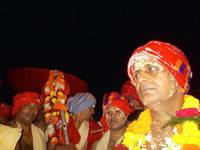 | 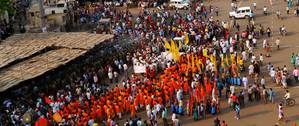 |
| Priests anointed with sandalwood paste set out to search for the holy neem trees. Photo: Roland Hardenberg | A procession of priests and pilgrims with security measures in the background. The authorities in Puri will have to manage some 5 million pilgrims at the height of this year’s Chariot Festival. Photo: Lisa Züfle |
 | 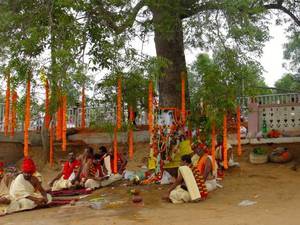 |
| A pilgrim pays homage at a holy neem tree. Photo: Roland Hardenberg | Priests at the tree which became the core of Sudarshana. Photo: Roland Hardenberg |
 |  |
| The ARSS construction company features Jagannatha (right) and his siblings on its banners for the infrastructure projects. Photo: Roland Hardenberg | Balabhadra, Subhadra and Jagannatha (left to right). Photo: Roland Hardenberg |
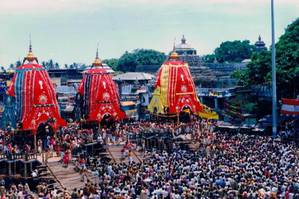 | 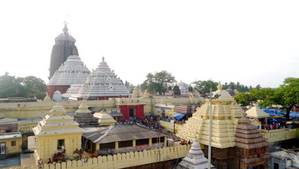 |
| Chariot Festival Ratha Yatra in Puri, 1996. Photo: Roland Hardenberg | The Temple of Jagannatha in Puri. Photo: Lisa Züfle |
Contact:
SFB 1070 RessourcenKulturen
Press and public relations
Alexandra Niskios, M.A.
<link mail window for sending>alexandra.niskios[at]uni-tuebingen.de
Phone +49 7071 29-73586
Professor Roland Hardenberg
University of Tübingen
Faculty of Humanities
Social and Cultural Anthropology
Phone +49 7071 29-78537
<link mail window for sending>roland.hardenberg[at]uni-tuebingen.de
